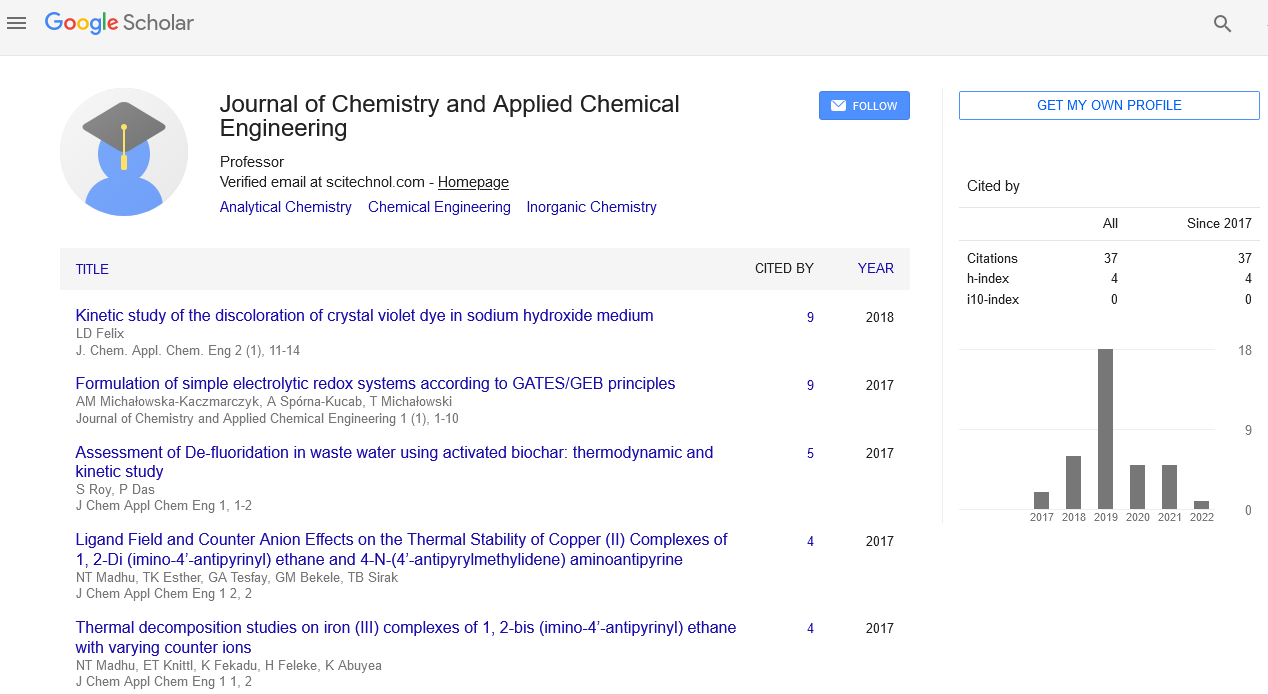Perspective, J Chem Appl Chem Eng Vol: 7 Issue: 1
Development of Novel Materials for Water Treatment and Remediation
Richard Alexa*
Department of Pure and Applied Chemistry, University of Strathclyde, Glasgow, United Kingdom
*Corresponding Author: Richard Alexa
Department of Pure and Applied
Chemistry, University of Strathclyde, Glasgow, United Kingdom
E-mail: a.richard@us.ac.uk
Received date: 28 February, 2023, Manuscript No. JCACE-23-95546;
Editor assigned date: 03 March, 2023, Pre QC No. JCACE23-95546(PQ);
Reviewed date: 17 March, 2023, QC No. JCACE-23-95546;
Revised date: 24 March, 2023, Manuscript No. JCACE-23-95546 (R);
Published date: 31 March, 2023, DOI: 10.4172/Jcace.1000e019
Citation: Alexa R (2023) Development of Novel Materials for Water Treatment and Remediation. J Chem Appl Chem Eng 7:1.
Description
Water is a fundamental resource for human and environmental wellbeing. It is essential to human life and plays a vital role in agriculture, industry, and recreation. However, water resources are under tremendous pressure from the increasing global population and industrialization. Human activities, such as agriculture, mining, and industrial processes, have resulted in the contamination of water bodies. Therefore, water treatment and remediation have become important to ensure the availability of clean and safe water for consumption and industrial use.
Developing novel materials for water treatment and remediation has been an ongoing research area. Traditional water treatment methods, such as coagulation, flocculation, and sedimentation, have limitations in removing contaminants from water, such as heavy metals, pesticides, and pharmaceuticals. Novel materials offer a potrntial alternative to traditional methods due to their high selectivity, reusability, and effectiveness in removing contaminants from water.
One of the novel materials for water treatment is adsorbents. Adsorbents are materials that attract and retain contaminants onto their surface. The surface properties of the adsorbent, such as surface area, pore size, and surface chemistry, influence the adsorption capacity of the material. Activated carbon is an example of an adsorbent used for water treatment. It has a large surface area, high porosity, and high adsorption capacity for organic and inorganic contaminants. However, activated carbon is expensive and requires regeneration after use.
Another novel material for water treatment is nanomaterials. Nanomaterials have unique physical and chemical properties due to their small size and high surface area to volume ratio. They have been used for the removal of contaminants such as heavy metals, organic compounds, and pathogens. Examples of nanomaterials used for water treatment include Zero-Valent Iron (ZVI) nanoparticles, Titanium Dioxide (TiO2) nanoparticles, and graphene oxide. ZVI nanoparticles are effective in removing heavy metals from water by reducing them to less toxic forms. TiO2 nanoparticles are photo catalysts that degrade organic compounds in water under sunlight. Graphene oxide has high adsorption capacity for contaminants due to its large surface area and high reactivity.
Furthermore, membrane-based technologies have been developed for water treatment and remediation. Membranes are thin, semipermeable barriers that separate contaminants from water based on their size, charge, and chemical properties. Membrane-based technologies include nano filtration, ultrafiltration, and reverse osmosis. These technologies have been used for desalination, removal of dissolved solids, and removal of microorganisms from water. Membrane fouling, which is the deposition of contaminants onto the membrane surface, is a challenge in membrane-based technologies.
Moreover, biopolymers have emerged as novel materials for water treatment and remediation. Biopolymers are natural polymers derived from renewable sources such as plants and microorganisms. They have high biodegradability, biocompatibility, and low toxicity, making them attractive materials for water treatment. Examples of biopolymers used for water treatment include chitosan, alginate, and cellulose. Chitosan is a biopolymer derived from chitin and has high adsorption capacity for heavy metals and organic compounds. Alginate is a biopolymer derived from brown seaweed and has been used for the removal of heavy metals and dyes from water. Cellulose is a biopolymer derived from plant cell walls and has been used for the removal of dyes from water.
Developing novel materials for water treatment and remediation is an important area of research. Adsorbents, nanomaterials, membranebased technologies, and biopolymers offer potential alternatives to traditional water treatment methods. These materials have unique properties that make them effective in removing contaminants from water.
 Spanish
Spanish  Chinese
Chinese  Russian
Russian  German
German  French
French  Japanese
Japanese  Portuguese
Portuguese  Hindi
Hindi 